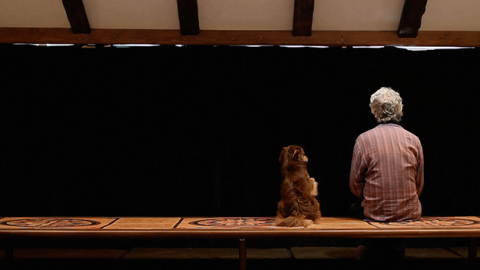
Review: Taxi
The good news is that Jafar Panahi is out. Out, that is, from the cloistered world he inhabited in his last two films: his Tehran apartment in This Is Not a Film (11), following his six-year jail sentence and 20-year ban on filmmaking for “making propaganda against the system”; and then a house by the Caspian Sea in Closed Curtain (13), where the closing down of his creative life was driving him to thoughts of mortal termination. In Taxi, he is good-humored, outgoing, almost jovial at times, plying a new, made-up trade as a taxi driver. We’re inside his cab for the whole film, as he picks up passengers who—seemingly—play out fragments of daily life for the benefit of Panahi’s dashboard-mounted camera.

Is there bad news to go with this? Perhaps not—only the same news differently weighted, seen from a reverse angle. Taxi opens with a long static shot from the taxi’s camera, pointed outward, as Panahi cruises down a Tehran thoroughfare. Two passengers eventually get in: a young man and a woman who are soon arguing over political views, hardline versus liberal. They are the first of several fares, representing a cross-section of people and professions—a comic thread is that they are not impressed by Panahi’s skills as a cabbie—in a film that has been described as documentary-like, a “portrait of the Iranian capital.”
What develops is not a documentary but a rehearsal of the guiding principles, and the methods, of Panahi’s cinema, before and after his arrest in 2010. He presents us with an infinite regression of setups, touching on both his own movies and the difficulties for any filmmaker of addressing Iranian “reality.” His first passenger, who describes himself as a “freelance mugger,” asks whether the camera is an anti-theft device, whereupon it is turned to face the backseat. The film then cuts to a reverse angle (but from what camera?) showing Panahi for the first time at the wheel, a cheerfully flat-capped cabbie. Conventional shot/reverse-shot editing takes in all the subsequent conversations. Another passenger, a pirate video peddler, “recognizes” Panahi and declares that the freelance mugger must have been a setup, a character riff on Crimson Gold (03).

Taxi can’t really be “out” like Panahi, or a form of documentary, because it depends on the kind of interior structures he has always favored, in which the imagery of cages and prisons advertises both the political subject matter and the problems of capturing and discussing it. Panahi picks up his niece Hana (Hana Saeidi) from school, and she comes with her own Canon camera (her jerky footage occasionally becomes the film). She wants a subject for a school exercise, a short film that must obey certain rules to be “distributable” by avoiding “sordid realism,” i.e., showing what’s “real but not real real.” It’s the reality that’s everywhere but is out of bounds for portrayal. Panahi looks for it when he jumps out of the cab at one point: he thinks he hears the voice of someone who interrogated him when he was blindfolded after his arrest.
The authorities who have banned Panahi from filmmaking appear to have joined him in a strange Alice in Wonderland world where—with a jail sentence hanging over him that looks unenforceable—he is both free and not free. When Panahi won the Golden Bear award at the Berlin Film Festival, the head of the Iran Cinema Organization responded by both congratulating him and condemning the award with a coy vehicular pun: “I am delighted to announce that the director of Taxi continues to drive in the fast lane of his life, freely enjoying all of its blessings.”






